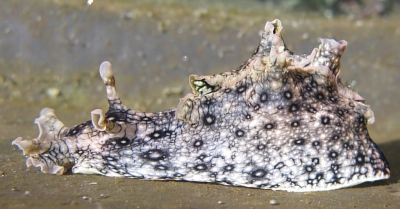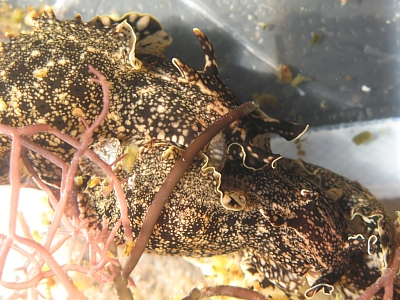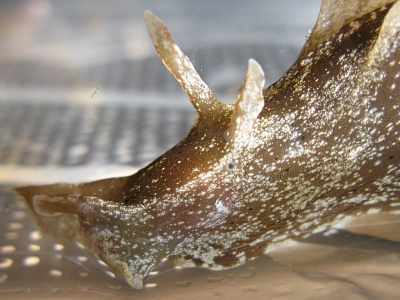Re: Feeding studies on Aplysia in Malaysia
July 21, 2007
From: Corvin Eidens


Concerning message #20022:
I contacted Prof. Klussmann-Kolb and she identified one of the sea hares (Aplysia dactylomela) and maybe the other one is Aplysia oculifera. I think there is also a third species.
I will attach some more pics.
Corvin Eidens
corvin@eidens.de
Eidens, C., 2007 (Jul 21) Re: Feeding studies on Aplysia in Malaysia. [Message in] Sea Slug Forum. Australian Museum, Sydney. Available from http://www.seaslugforum.net/find/20261
Dear Corvin,
Your message arrived after I had posted my comments on #20249. I'm glad my identification coincided with Annette Klussmann-Kolb's. I assume the three photos you attached represent the three supposed species. If so the top one is A. dactylomela and the bottom one - just the head - is A. oculifera. This leaves the middle one - the mating pair - as unidentified. I think at this stage it would be useful if you could send photos of these three 'species' as separate messages. It would be useful if you could include a juvenile and adult photo if you have them, and a side shot so we can see how far back the parapodia go.
The problem is that Aplysia taxonomy is in a mess - especially in the Indo-West Pacific. As I have said before, most species were described from preserved specimens and so fitting the descriptions to living aniamls has never been satisfactorily resolved. The only attempt at a world-wide revision (Eales, 1960) is based almost entirely on preserved specimens, and extremely difficult to use for species identification.
It's possible the animals in your middle photo are a form of A. dactylomela without rings. I know you study is not centred on the animals, but I suspect you are the only one who is going to be able to sort out how many species of Aplysia you have. All I can say is see who mates with whom. That is a pretty fundamental distinction. You will also see that different species have differences in shape and relative size of the parapodia - and the parapodia join differntly at the posterior ends in different species. In A. dactylomela the parapodia join quite high just behind the mantle cavity, while in A. oculifera they stay separate almost to the posterior tip of the tail. How does your third species compare? There will also be differences in shape of oral tentacles and rhinophores, and thickness and feel of the skin - and parapodial flaps. These differences are much easier to see in living animals.
Even if we can't put a name on your third species - if there is a third species - at least you will know you are dealing with three not two species.
Good Luck,
Bill Rudman
Related messages
-
Aplysia oculifera from Kerala, India
From: Dr. A. Biju Kumar, September 7, 2009 -
Aplysia? from Ratnagiri, India
From: Vishal J. Bhave., March 11, 2009 -
Aplysia kurodai ? in Indonesia
From: Teresa Zuberbühler, July 3, 2008 -
Re: Feeding studies on Aplysia in Malaysia
From: Corvin Eidens, June 29, 2007 -
Feeding studies on Aplysia in Malaysia
From: Corvin Eidens, June 15, 2007 -
Aplysia oculifera eating Enteromorpha
From: Philibert Bidgrain, November 21, 2006 -
Upset Sea Hare in Sth Africa
From: Sakkie du Preez, April 26, 2006 -
Aplysia oculifera laying eggs
From: Dong Bum Koh, May 14, 2005 -
Aplysia oculifera from Sth Korea
From: Dong Bum Koh, May 14, 2005 -
Mating Aplysia oculifera from Sth Korea
From: Dong Bum Koh, May 14, 2005 -
Aplysia oculifera from the Philippines
From: Erwin Koehler, June 3, 2003 -
Aplysia from Chek Jawa, Singapore
From: Ria Tan, February 3, 2003 -
Aplysia oculifera from Japan.
From: Jun Imamoto, December 22, 2001 -
Happy to see an Aplysia forum
From: Itai Plaut, May 26, 2000
